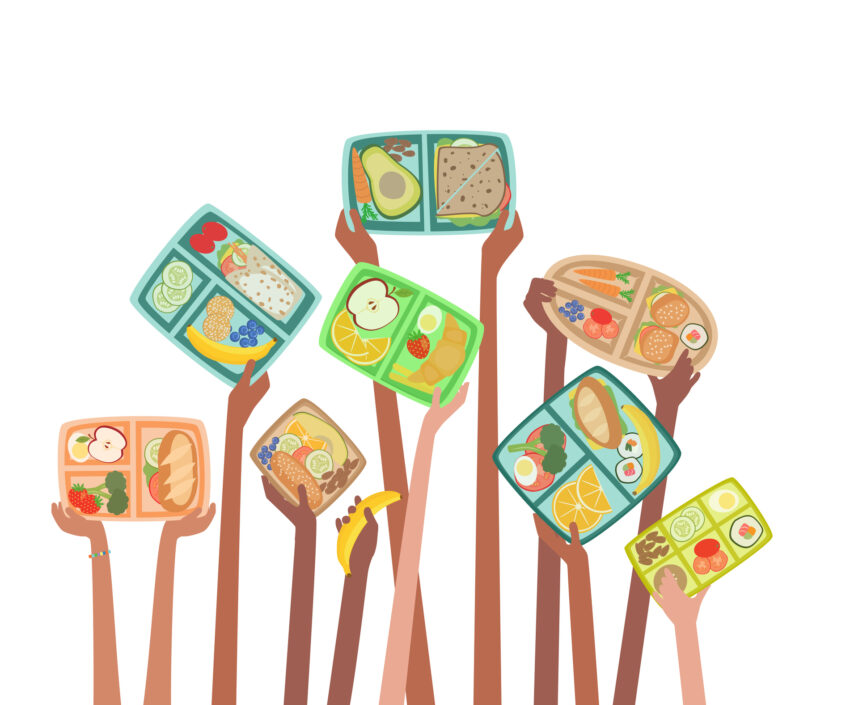
Share On Social!
Throughout the COVID-19 pandemic, many schools had the flexibility to offer school meals free to all public-school students.
Now, some of this flexibility is expiring and many schools can only serve free meals to certain students starting this 2022-2023 school year, according to the USDA.
“As we all get through this change, we ask everyone to be patient with school nutrition professionals and thank them for working to help children during such a tough time. The [USDA] and the Biden-Harris Administration fully support the school leaders and school meal heroes running the school meals programs,” according to the USDA.
For Latino students, whose families often face wage gaps and nutrition insecurity, these changes could have a significant impact.
Here is what these recent changes entail and what Latino parents should know regarding free meals for their children in school!
Update 8/11/22: California and Maine have made universal free school meals a permanent fixture for all students, while Vermont and Massachusetts extended universal free school meals one more year, Fox29 reports.
What Is Changing About School Meals?
Once the pandemic hit in March 2020, USDA enabled schools the option to serve free meals to all kids.
“Universal free school meals” meant families no longer had to meet income requirements to get free or reduced-price meals under the National School Lunch Program.
This not only prevented many students from going hungry during the pandemic, it improved student test scores, reduced discipline issues, and made it easier for schools and families to not deal with the paperwork and complexity of determining who is eligible.
“Some of the families you most want to reach through means-tested programs are the ones who are going to struggle the most to document income, resources or lack thereof,” said Indivar Dutta-Gupta, head of the nonprofit Center for Law and Social Policy, according to Marketplace. “Sometimes, these means-tested or targeted programs can exclude the very families who you want to reach.”
But, for the upcoming 2022-2023 school year, the eligibility requirements are back.
“So many schools can’t serve all meals free anymore. Instead, families will do what they did before COVID. Schools will take applications and use family income to qualify kids for free, reduce-price, or paid meals,” according to the USDA.
Will My Child’s School Still Offer Free Meals?
While these fee waivers are no longer being extended, there may still be an opportunity for children to receive free meals.
Some schools use a program called the “Community Eligibility Provision” (CEP) that helps them serve all meals free.
This non-pricing meal service option allows the nation’s highest-poverty schools and districts to serve breakfast and lunch for free to all enrolled students without collecting household applications.
Parents can search through a list of schools and districts across the nation to determine if their child’s school in enrolled in the CEP program.
While meals are offered during school, many children in rural or low-income areas need nutritious meals during the summertime.
“Summer Meals provide kids with the nutrition they need when school is out, and a safe haven where they can play and learn to keep their minds and bodies active during the summer months,” according to a 2017 USDA blog. “The availability of these meals, which are served at no cost to children 18 and under, also reduces the financial burden on caretakers when school is out of session.”
To find free meals for kids during the summer in your area, visit USDA’s Find Meals for Kids website.
What If I Can’t Afford to Pay for My Child’s School Meals?
The exit of universal free school meals comes at a tough financial time.

“Families across the country are facing a very difficult reality of having to choose between feeding their kids or filling up their gas tank or purchasing medicine,” Vince Hall, chief government relations officer for Feeding America, a nonprofit network of foodbanks told AP News.
With many financial stressors impacting parents across the country, Latino parents also must deal with low income and food insecurity.
Latino Americans make just 73 cents for every dollar earned by White Americans.
“Due to the coronavirus pandemic, food insecurity among Latinos rose from almost 16% in 2019 to more than 19% in 2020,” according to Feeding America.
Still, Latino families can get assistance with school meals.
Children are automatically eligible for free meals if anyone in their household gets SNAP, TANF, or FDPIR benefits.
In some states, families with Medicaid may also be eligible for free meals depending on their income.
Go here to find 2022-2023 Income Eligibility Guidelines for Child Nutrition Programs.
Challenges in Latinos Accessing Healthy Food
Healthy food access is critical for Latinos.
“When Latino kids have access to free, healthy options, they’re lessening the chances for health complications later in life,” wrote Julia Weiss in a Salud America! resource guide.
But Latino students have more access than white students to unhealthy foods and drinks in school stores, snack lines, and vending machines.
Nutritious, healthy, and accessible school meals are essential for Latino children.
School Nutrition Standards for meals are in correlation with the Healthy, Hunger-Free Kids Act of 2010, which authorizes funding for federal school meal and child nutrition programs and increases access to healthy food for low-income children.
Some of the nutrition standards for meals served in schools include:
- Fruits and vegetables
- Whole grains
- Calorie limits
- Sodium limits
- Limits on unhealthy fat
- Low-fat and fat-free milk
- Free water
While some standards were previously rolled back throughout the Trump administration, the Biden administration announced the USDA would change its school nutrition standards for the 2022-2023 school year, reinstating health goals.
According to the CDC, “Research shows that students who participate in the school meal programs consume more whole grains, milk, fruits, and vegetables during meal times and have better overall diet quality, than nonparticipants.”
The COVID-19 pandemic has brought upon supply chain issues and shortages for school cafeterias across the country.
“The school district has dealt with inconsistent deliveries of food and supplies, like trays and utensils, which is an added layer of stress on school staff who are coming back from a year of mostly remote learning due to the COVID pandemic,” reported NBC News.
In February 2022, the USDA issued transitional nutrition standards for School Year 2022-23 and 2023-24 to ease requirements due to challenges brought on by the COVID-19 pandemic.
During the 2022-23 school year, schools that cannot meet these standards due to supply chain disruptions will not be penalized.
What’s Next for School Meals?
In June 2022, President Joe Biden signed the Keep Kids Fed Act, which equips schools, summer meal sites, and childcare food programs with extra resources so they can continue serving children through school year 2022-2023. This enables USDA to offer a suite of operational flexibilities that will be available to child nutrition programs for summer 2022 and school year 2022-23.
But the this does not include universal free school meals for all students.
Only Congress can change the eligibility requirements for free meals, NPR reports.
“Some schools are preparing to raise meal prices, meaning that families who were paying before the pandemic will now pay more when the waivers expire,” according to NPR. “Only students with a family income of 185% of the poverty level or below will qualify.”
For now, USDA lists several resources to ensure nutritious meals for children and families outside of school.
MyPlate informs families on the importance of eating from the five food groups and includes a menu planner to ensure the groups are being implemented in daily meals. English and Spanish options are available.
Be Your Best With Breakfast is also a resource for families that encourages them to eat breakfast and offers tips on recipes. English and Spanish versions are also available.
For more resources and food assistance programs, contact the USDA’s National Hunger Hotline.
Reach out to 1-866-3-HUNGRY (for English) and 1-877-8-HAMBRE (for Spanish).
How Can You Step Up for Healthy Food in Your Community?
You can also make a difference in your community’s nutrition.
Download a Salud America! Health Equity Report Card!
The report card will show you how many local children live in poverty and food deserts, how many have low food access, and how many get SNAP food benefits. Then you can compare it to your state and to the country.
Email your Health Equity Report Card to community leaders, share it on social media, and use it to make the case to address food insecurity where help is needed most!
By The Numbers
142
Percent
Expected rise in Latino cancer cases in coming years



